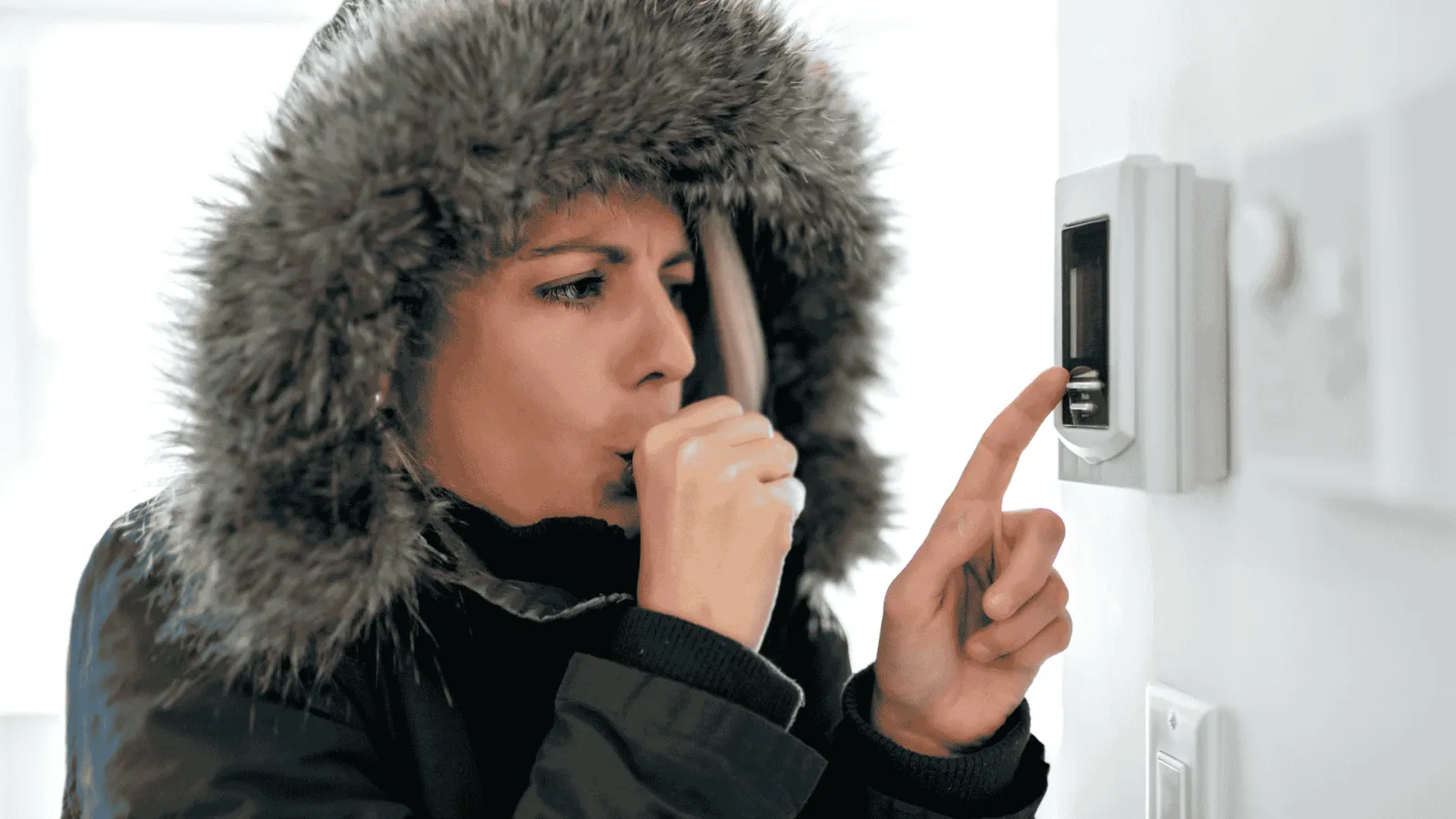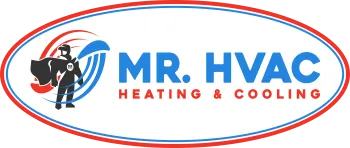When temperatures drop and your heating system suddenly stops working, your comfortable home can quickly become uncomfortably cold. Whether your heater won't turn on at all, randomly shuts off, or runs but fails to produce warm air, heating problems require immediate attention.

Understanding why your heat stopped working helps you determine whether it's a simple fix you can handle on your own or a situation that requires professional assistance. In this guide, we'll walk through the five most common reasons homeowners experience heating failures and explain exactly what to do about each one.
1. Lack of Regular Maintenance
The most common reason your central heater is not working properly is neglecting routine maintenance. Without annual tune-ups, dust and debris accumulate throughout your system, leading to component failure.
Dirty air filters restrict airflow, forcing your furnace to overheat. A clogged blower motor prevents proper heat distribution. The flame sensor becomes covered in residue and shuts off your heater shortly after startup. These problems develop gradually but eventually cause complete system failure.
A professional tune-up includes cleaning components, testing safety controls, checking gas connections, and measuring system performance. If you've been putting off maintenance and now your heat won't work, scheduling professional furnace service addresses these accumulated issues.
What to do: Replace your air filter first. If that doesn't resolve the issue, schedule a comprehensive tune-up.
2. Thermostat Problems
Your thermostat is the command center for your heating system. When it malfunctions, your furnace won't receive proper signals. Common signs include the heater not turning on at the right times, temperature not matching your settings, or a blank display.
Before calling for heating repair, verify your thermostat is set to "Heat" mode and the temperature is at least five degrees higher than the current room temperature. Replace the batteries if your model is battery-operated. Check that programming schedules haven't been accidentally changed.
If basic troubleshooting doesn't work, the thermostat might need recalibration or replacement. Wiring problems can also prevent proper communication with your furnace. These situations require professional diagnosis and repair.
What to do: Check the mode, temperature setting, and batteries first. If the problem persists, call a technician to test the thermostat and wiring.
3. Electrical or Power Supply Issues
Even gas furnaces need electricity to operate. The blower motor, control board, ignition system, and safety sensors all require power. When your central heater won't turn on at all, a power supply problem is likely.
Check your electrical panel for a tripped breaker. Reset it by pushing fully to "Off" first, then flipping back to "On." If the breaker trips again immediately, don't keep resetting it. Repeated tripping indicates a serious electrical issue, such as a short circuit or a failing component.
Older homes with fuse boxes should check for blown fuses. Replace them with the same amperage rating. Other electrical issues include a failing blower capacitor or loose wiring connections inside the furnace.
If resetting the breaker doesn't restore heat, electrical problems require professional attention for safety and to prevent damage to expensive components.
What to do: Check and reset your breaker once. If it trips again or the heat still doesn't work, contact an HVAC technician for an electrical system diagnosis.
4. Low Refrigerant Levels in Heat Pumps
If your home uses a heat pump, low refrigerant prevents efficient heating. Heat pumps transfer heat using refrigerant, and when levels drop due to leaks, performance suffers dramatically.
Signs include emergency heat strips turning on too frequently, the system running continuously without adequately heating your home, and ice buildup on the outdoor unit. Refrigerant doesn't get used up, so low levels always mean there's a leak somewhere in the system.
Running with insufficient refrigerant forces the compressor to work harder and eventually fail. Compressor replacement costs often exceed the cost of a new system installation, making early detection critical.
Only certified HVAC technicians are authorized to legally check refrigerant levels, locate leaks, and recharge your system properly.
What to do: If you suspect refrigerant issues, schedule professional heat pump service immediately to prevent damage to the compressor.
5. Poor Ductwork Design or Installation
Sometimes your heater runs perfectly, but your house stays cold. The problem may be due to poorly designed or damaged ductwork, which prevents heated air from reaching your living spaces.
Common ductwork issues include leaks in seams that allow heated air to escape into attics and crawl spaces, improperly sized ducts that restrict airflow, and pressure imbalances that cause your heater to short-cycle. You'll notice uneven heating, weak airflow from vents, and strange whistling or rattling sounds.
Professional technicians can perform pressure tests to identify leak locations and evaluate whether your ductwork is properly sized. Many homeowners lose 20 to 30 percent of their heated air due to duct problems. Sealing leaks and optimizing your duct system can dramatically improve heating efficiency while reducing energy bills.
What to do: If you experience persistent uneven heating or weak airflow, schedule a ductwork inspection with your furnace service appointment.
When to Call a Professional for Heating Repair
While some heating issues have simple solutions, many problems require professional expertise to resolve. Call immediately if you smell gas anywhere near your system or if your carbon monoxide detector sounds an alarm. Evacuate and call emergency services.
Other situations requiring professional help include loud banging or grinding noises, circuit breakers that repeatedly trip, visible flames or smoke, water pooling around your system, or a pilot light that won't stay lit.
If basic troubleshooting, such as checking the thermostat, replacing the filter, and resetting breakers, doesn't work, call an expert. Early professional diagnosis often results in simpler, less costly repairs.
Expert Furnace Repair Services
When your heat stops working, you need reliable service from experienced technicians who can diagnose and fix the problem quickly. MR. HVAC serves homeowners with honest, professional heating repair services.
Our licensed technicians bring 25-plus years of experience diagnosing and repairing all types of heating systems. We offer same-day service for emergencies and provide upfront pricing with no hidden fees. Whether you need a minor repair, complete system maintenance, or expert advice on replacement options, we help you make informed decisions for your home and budget.
Don't spend another cold day or night wondering why your heat isn't working. Contact MR. HVAC for fast, reliable furnace repair and maintenance services that restore comfort to your home.
Frequently Asked Questions
Why does my heater randomly turn off?
If your heater turns off randomly, the most common causes are a dirty flame sensor, restricted airflow from a clogged filter, or a malfunctioning thermostat sending incorrect signals. The flame sensor detects whether the burner is lit, and when it gets covered in residue, it can't sense the flame properly and shuts the system down for safety. Check and replace your filter first, then have a technician clean the flame sensor if the problem continues.
Can I fix my heater myself or should I call a professional?
Simple tasks, such as replacing your air filter, checking thermostat batteries, and resetting a tripped breaker, are safe DIY fixes. However, anything involving gas connections, electrical repairs, refrigerant handling, or internal furnace components requires professional expertise. Attempting complex repairs yourself can damage your system, void your warranty, or create hazardous situations with gas leaks or carbon monoxide exposure.
How much does it cost to repair a heating system that's not working?
Heating repair costs vary widely depending on the problem. Simple fixes, such as thermostat replacement, might cost $100 to $250, while component replacements, like a blower motor or gas valve, typically range from $300 to $800. Major repairs involving the heat exchanger or control board can exceed $1,000. A professional diagnosis identifies the exact issue and provides an accurate estimate before any work begins.
How often should I schedule furnace maintenance?
Schedule professional furnace maintenance once per year, ideally in early fall before heating season begins. Annual tune-ups prevent most emergency breakdowns, improve energy efficiency, extend equipment life, and maintain manufacturer warranties. Regular maintenance costs significantly less than emergency repairs and provides peace of mind that your heating system will function reliably when you need it most.
What are the signs my heating system needs to be replaced rather than repaired?
Consider replacement if your furnace is over 15 years old and experiencing frequent breakdowns, if repair costs exceed 50 percent of a new system's price, if your energy bills continue to increase despite repairs, or if your home has uneven heating that ductwork repairs can't solve. A professional assessment can help you determine whether repair or replacement is the most financially sensible option for your specific situation.

